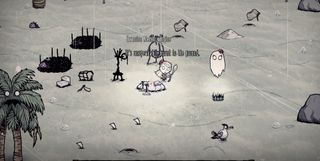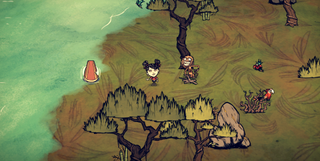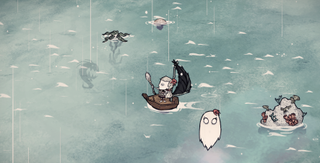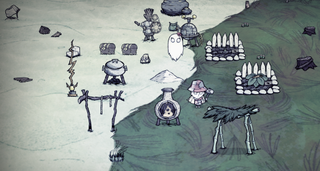
Returning to Don’t Starve’s world of goth survival whimsy is like slipping into a bubble bath full of piranha. You’re happy, but braced for impact. The Shipwrecked DLC is currently in Early Access, so some content remains to be added and balance changes will be made based on feedback, (there’s a roadmap here), but what’s available now feels like a sufficiently interesting twist on the formula to make me want to spend a lot time in the tropical deathtrap that Klei Entertainment and Capybara Games have co-developed.
The key change is the setting. You wake on an island amidst the wreckage of a boat, and from there it’s the familiar Don’t Starve rush to gather resources, build tools, and harvest food before the onset of night, which is lethal without the protection of fire. But whereas in previous iterations you could pretty much just scout for a plum location—ideally with Beefalo and plenty of fresh veg located within walking distance—and then turtle up at your base, in Shipwrecked you’re aggressively encouraged to explore.
Inevitably, the ocean life is not an easy one. Building a basic raft is easy enough, but it’s fragile and slow. Soon you’ll want to upgrade to a rowboat, which can be equipped with a thatch sail and even a lantern for night maneuvers. Waves vary in height, and timed right can be used for a speed boost, but there’s a risk/reward payoff because if you take on too much water your items will get sodden, and ultimately you can sink.

Each procedurally-generated world is an archipelago, with different biomes spread across islands which vary wildly in size. Because certain items remain crucial to progress—like gold nuggets to build your first science machine, or spider silk to craft bug nets—there’s almost no point in laying down roots until you’ve secured a decent source of the most important materials. Which is going to mean heading out to sea.
Whilst sailing you’ll discover coral reefs, which can be mined and then turned into limestone, plus jellyfish and seaweed to cook back in your crock pot. In about half a dozen playthroughs I’ve only been attacked once on water, which was by a Sea Hound that I evaded easily enough after the initial ohshitohshit reaction. I suspect my relative safety so far is because the Tiger Shark boss has yet to be implemented. When that thing is prowling the waters, weaponising your boat with cannons will likely become a more pressing concern. Boats can also be equipped with trawl nets that will scoop up fish, mussels, useless junk, and—if you’re lucky—rare items depending on what season you’re in.
Climate of fear
As ever, it’s climate that’s the big killer in Don’t Starve. You start off in the false sense of security that is the Mild Season, when it’s comparatively easy to find food and make shelter. That’s followed by Hurricane Season, which is about exactly as rough as it sounds. If you haven’t bothered building a lightning rod, your sweet camp will be zapped to a smouldering insurance claim within seconds of the first storm starting. Then there’s to hail to contend with. You can pick up hailstones and use them as filler in crockpot recipes (much like sticks), but beware that a bug currently means that those icy nuggets left on the ground will constantly bang into any walls you’ve built, eventually destroying them. The developers are working on a fix.
After the hurricanes comes Monsoon Season. Here the land will get progressively more flooded, potentially waterlogging your vital crafting machines. (Semi-pro tip: craft a chiminea early because the flames will stay sheltered from wind and rain.) Making matters worse—in Don’t Starve, it’s always worse—poisonous mosquitoes begin to spawn in flooded areas. Getting poisoned, which can also happen from snake and spider bites, results in a swift, panicky death unless you’ve crafted some anti-venom. Unfortunately, to craft anti-venom you first need to kill one of the poisonous critters, ideally before it kills you, and hope it drops a venom gland. The mechanic is a source of complaint in the community and also on the balance to-do list.
PC Gamer Newsletter
Sign up to get the best content of the week, and great gaming deals, as picked by the editors.
Dry Season comes last and sees overheating become an issue. Or not, if like me you’ve already lashed together a siesta lean-to and an ice making machine. Admittedly, neither of those were much help when I was overwhelmed by a pack of dogs (which are still a thing) and didn’t have my ghostly twin sister around to help out. (I’ve mostly been playing as Wendy—“The Bereaved”, whose spectral sibling is great at killing mobs, but plan to try Walani, who comes with a surfboard, soon.) As for the rest of Dry Season, it apparently features volcanic eruptions. Good luck staving off fiery rocks with a bamboo umbrella. I have to confess I haven’t encountered this yet as my best save lasted around 50 days—a far cry from the 300+ marathon I managed to pull off in the vanilla game. Still, I’m definitely feeling the old compulsion to keep playing.

Super monkey balls
Double screening is one of the great joys of PC gaming, and I play a lot of my favourite games while half-watching TV shows on the other monitor. But with Don’t Starve I have to stick to music or, at most, a podcast, because I can’t risk taking my eyes off what’s happening. That’s how fatal poisonings happen. There’s actually almost an RTS vibe to it, because maximising the efficiency of your clicks leads to the most efficient resource haul. But the meta game is all about gearing up to survive the next season. Once you find the right groove, it’s remarkable how safe Shipwrecked starts to feel. Which is usually exactly when the piranha in the bath sinks its teeth into your balls.
Shipwrecked sadly doesn’t do anything to fix some of the structural problems Don’t Starve has always suffered from. After a great run comes to an end, it feels onerous to have to slog through the early hours of busywork required to construct an even half-decent homestead. Also, the variation between a new world in which vital resources are initially spawned nearby and one in which you struggle to find anything useful feels way too wide. Perhaps the world-building algorithm can be tweaked so the initial RNG doesn’t have quite such a big impact. Or maybe that would reduce the thrill of discovery.
Much of Don’t Starve’s considerable magic resides in stumbling across something you haven’t found before, then working out how to benefit from it. I’ve spent some time trying to work out how to farm Shipwrecked’s prime apes—infuriatingly cute monkeys which steal any nearby items you drop—for their meat and manure. You can distract them with a Silly Monkey Ball, but it costs a lot of stuff to craft. In a final act of desperation I tried to burn the entire forest around them, but as I was whispering “the horror, the horror”, they emerged unscathed and stole my coconuts. Still, at least the weather’s nice. For now.

With over two decades covering videogames, Tim has been there from the beginning. In his case, that meant playing Elite in 'co-op' on a BBC Micro (one player uses the movement keys, the other shoots) until his parents finally caved and bought an Amstrad CPC 6128. These days, when not steering the good ship PC Gamer, Tim spends his time complaining that all Priest mains in Hearthstone are degenerates and raiding in Destiny 2. He's almost certainly doing one of these right now.
Most Popular



